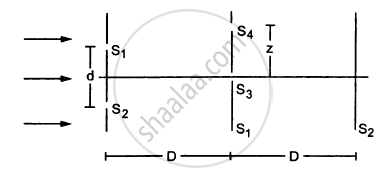Advertisements
Advertisements
Question
Using the monochromatic light of the wavelength in the experimental set-up of the diffraction pattern as well as in the interference pattern where the slit separation is 1 mm, 10 interference fringes are found to be within the central maximum of the diffraction pattern. Determine the width of the single slit, if the screen is kept at the same distance from the slit in the two cases.
Solution
If a is the width of the single slit, then for the central maximum of the single slit diffraction pattern,
`sin theta ≈ theta = lambda_1/"a"`
⇒ Total angular width, `2 theta = (2lambda_1)/"a"` ...(1)
For 10 interference fringes of the double-slit interference pattern to lie within the central maximum of the single slit pattern,
⇒ Total angular width, `2 theta = 10(2lambda_2)/"d"` ...(2).....(d is the separation between the slits).
From equation 1 and 2, `(2lambda_1)/"a" = (102lambda_2)/"d"`
As the light of the same wavelength is used in both cases, so λ1 = λ2
Hence,
`2/"a" = 10/"d"`
⇒ `"a" ="d"/5 = 1/5 "mm" = 0.2 "mm"`
⇒ a = 0.2 mm
APPEARS IN
RELATED QUESTIONS
When monochromatic light is incident on a surface separating two media, the reflected and refracted light both have the same frequency as the incident frequency.
In the wave picture of light, the intensity of light is determined by the square of the amplitude of the wave. What determines the intensity in the photon picture of light?
What kind of fringes do you expect to observe if white light is used instead of monochromatic light?
A monochromatic ray of light falls on a regular prism. What is the relation between the angle of incidence and angle of emergence in the case of minimum deviation?
Monochromatic light of frequency 5.0 × 1014 Hz is produced by a laser. The power emitted is 3.0 × 10–3 W. Estimate the number of photons emitted per second on an average by the source ?
When monochromatic light is incident on a surface separating two media, why does the refracted light have the same frequency as that of the incident light?
Obtain the conditions for the bright and dark fringes in diffraction pattern due to a single narrow slit illuminated by a monochromatic source.
Explain clearly why the secondary maxima go on becoming weaker with increasing.
Consider the situation shown in the figure. The two slits S1 and S2 placed symmetrically around the central line are illuminated by a monochromatic light of wavelength λ. The separation between the slits is d. The light transmitted by the slits falls on a screen ∑1placed at a distance D from the slits. The slit S3 is at the central line and the slit S4 is at a distance z from S3. Another screen ∑2 is placed a further distance D away from ∑1.Find the ratio of the maximum to minimum intensity observed on ∑2 if z is equal to

(a) \[z = \frac{\lambda D}{2d}\]
(b) \[\frac{\lambda D}{d}\]
(c) \[\frac{\lambda D}{4d}\]
Find the angle of incidence at which a ray of monochromatic light should be incident on the first surface AB of a regular glass prism ABC so that the emergent ray grazes the adjacent surface AC. (Refractive Index of glass = 1 .56)
Assertion(A): The photoelectrons produced by a monochromatic light beam incident on a metal surface have a spread in their kinetic energies.
Reason(R): The energy of electrons emitted from inside the metal surface, is lost in collision with the other atoms in the metal.
